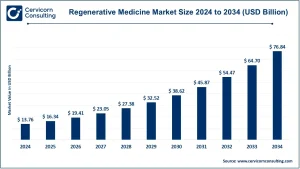Immunoassays Market Overview
The global immunoassays market was valued at around USD 35.15 billion in 2024 and is anticipated to reach approximately USD 62.24 billion by 2034, registering a CAGR of 5.88% over the forecast period. Immunoassays are increasingly utilized in clinical diagnostics due to their rapid, accurate, and scalable testing capabilities for infectious diseases, chronic conditions, and personalized medicine applications. The adoption of immunoassays is further supported by automation-ready analyzers, environmentally sustainable assay kits, and integration with point-of-care diagnostics, establishing them as a cornerstone of modern healthcare.
Get a Free Sample: https://www.cervicornconsulting.com/sample/2765
Key Market Trends
-
Eco-friendly Immunoassays – Sustainability is gaining importance in diagnostics. Companies are transitioning from conventional plastics to biodegradable or recyclable materials in assay plates to reduce environmental impact. For example, Abbott announced in 2025 a roadmap to minimize single-use plastics in diagnostic kits.
-
Digital Integration & AI – Immunoassay systems are increasingly connected to cloud platforms and powered by AI analytics, enabling real-time monitoring, predictive insights, and seamless integration with electronic medical records (EMRs). Roche Diagnostics introduced AI-enabled analyzers in 2025 to improve throughput and digital connectivity.
-
Automation & High-Throughput Testing – Automated immunoassay analyzers are gaining traction in hospitals and large laboratories, enhancing efficiency, reproducibility, and patient outcomes.
-
Point-of-Care Testing (POCT) – Rising demand for rapid bedside diagnostics is driving the development of portable and user-friendly immunoassays, especially for infectious disease detection.
-
Non-invasive Specimens – While blood remains the primary sample, saliva and urine-based immunoassays are expanding, particularly in home-based or outpatient testing, improving patient convenience.
Market Drivers
-
Rising Disease Burden: The increasing prevalence of infectious diseases (COVID-19 variants, influenza, HIV) and chronic conditions (cancer, diabetes, cardiovascular disorders) is driving the need for precise and scalable immunoassays.
-
Technological Advancements: Developments in chemiluminescent immunoassays (CLIA), high-sensitivity ELISA kits, and AI-powered analyzers are facilitating rapid and reliable diagnostics.
-
Government Initiatives & Healthcare Investments: Policies promoting early disease detection, personalized medicine, and digital healthcare adoption are boosting immunoassay usage, particularly in North America and Asia-Pacific.
-
Telemedicine & Home Diagnostics: The growth of remote patient monitoring and home-based testing kits enhances accessibility, convenience, and patient adherence.
Impact of Trends and Drivers
The above trends and drivers are reshaping regional adoption patterns and product preferences:
-
North America leads adoption with its advanced healthcare infrastructure, embracing automated and AI-driven immunoassays.
-
Asia-Pacific is the fastest-growing region, supported by expanding healthcare access and infectious disease programs.
-
Product Segments: Reagents & kits dominate the market with a 56.6% share, while analyzers and instruments benefit from automation trends.
-
Applications: Infectious disease testing holds the largest market share (39.7%) due to the need for rapid pathogen detection.
Challenges & Opportunities
Challenges: High costs of advanced immunoassay systems, regulatory compliance, and limited awareness in emerging markets.
Opportunities: Growth prospects include eco-friendly and portable immunoassays, AI and digital integration, and non-invasive testing, enabling new market penetration.
Future Outlook
The immunoassays market is expected to evolve into a more digital, sustainable, and patient-centric ecosystem. With a CAGR of 5.88%, the market could reach USD 62.24 billion by 2034. Emerging trends such as AI-powered predictive analytics, non-invasive diagnostics, and point-of-care testing are set to redefine clinical workflows, enhance early disease detection, and improve patient outcomes globally.
For a Detailed Market Overview and Custom Insights: https://www.cervicornconsulting.com/contact-us


